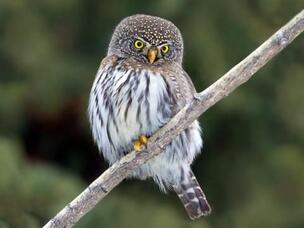 The Northern Pygmy Owl is one of the smallest owls in the US, and has been spotted at Galena Creek Regional Park! Photo: All About Birds The Northern Pygmy Owl is one of the smallest owls in the US, and has been spotted at Galena Creek Regional Park! Photo: All About Birds Owls are fierce predators and unique in the bird world for several reasons. 1. The first and most obvious adaptation is that they are nocturnal, although this isn’t always true. Most owls are active in catching and eating prey at night but many are still awake during the day. Some owls, like the Northern Pygmy Owl and the Burrowing Owl, are primarily active during the day. 2. They have fringed flight feathers that muffle sound and allow them to fly almost silently. This helps them sneak up and surprise prey. This adaptation is complemented by their strong talons, which help them hold on to large prey. 3. Another well-known adaptation is their flexible head; owls can turn their heads up to 270° to track their prey by sight and sound. 4. Finally, owls are similar to other predators in that their eyes are placed at the front of their head (as opposed to the sides like most songbirds and prey animals); this adaptation improves their depth perception, helping them track and catch prey. Prey animals have eyes on the sides of their heads because that increases their field of vision, allowing them to see predators and other threats. What other owl adaptations can you think of? More Information: Owl Research Institute
5 Comments
10/22/2023 10:25:23 pm
I find it fascinating how Galena Creek Regional Park showcases the incredible world of owls. These birds of prey possess a set of remarkable adaptations that make them some of the coolest animals in the avian kingdom. One of their most striking features is their nocturnal nature, although some, like the Northern Pygmy Owl and the Burrowing Owl, are active during the day. What's even more intriguing is their fringed flight feathers, which enable them to fly nearly silently, allowing them to sneak up on unsuspecting prey. Paired with their powerful talons for a secure grip and the ability to rotate their heads up to 270°, owls are true masters of stealthy hunting. Additionally, their forward-facing eyes provide exceptional depth perception, aiding in their precision while tracking and catching prey. The Galena Creek Visitor Center's insights into these adaptations offer a newfound appreciation for these enigmatic birds.
Reply
2/15/2024 11:37:01 am
Reply
Leave a Reply. |
AuthorThis blog is managed by the staff and volunteers of Galena Creek Visitor Center. We write about parts of the natural world that we find fascinating and want to teach others about, as well as keeping you updated on the Visitor Center and park. If you want to learn more, please sign up for our monthly newsletter, where we share upcoming events, updates on the ecology of the park, and highlights from each month. Archives
October 2021
Categories |
 RSS Feed
RSS Feed
